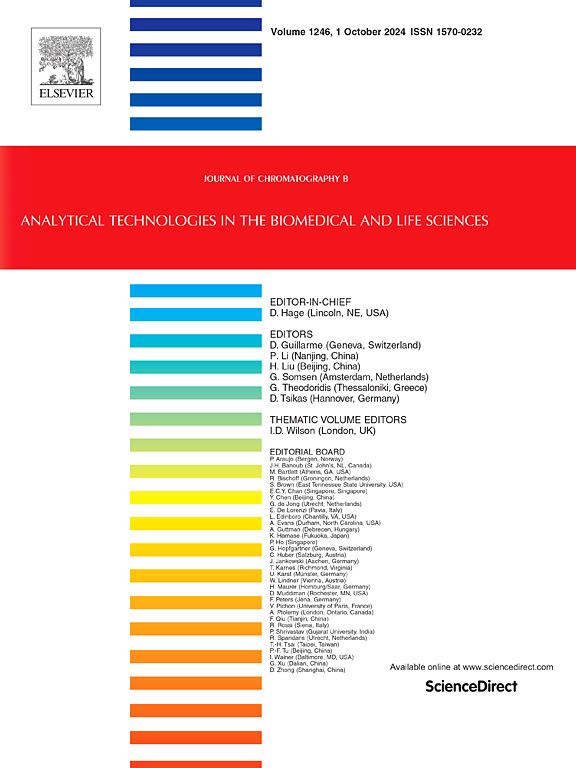Development and validation of a ‘dilute and shoot’ LC–MS/MS method in urine suitable for screening and confirmation analyses in a clinical setting
IF 2.8
3区 医学
Q2 BIOCHEMICAL RESEARCH METHODS
引用次数: 0
Abstract
Urine toxicological analysis serves as a significant tool in both clinical and forensic contexts, facilitating the diagnosis of acute intoxications, determination of causes of death, monitoring of substance use in occupational settings, and identification of drug-facilitated crimes. In this regard, the dilute-and-shoot method, when integrated with liquid chromatography-tandem mass spectrometry (LC–MS/MS), represents a promising analytical approach due to its efficacy, reliability, and wide-ranging applicability. This study presents the development and validation of an LC–MS/MS method that simultaneously detects and quantitates 115 drugs and metabolites comprising analytes from different categories, such as drugs of abuse (DOA), new psychoactive substances (NPS), prescription and over-the-counter drugs. Sample pretreatment was studied by applying different solvents (acetonitrile, water or methanol), and the best results were obtained after adding 100 μL of sample, 200 μL of a mixture of methanol: acetonitrile (3:1, v/v). The mixture was vortexed, centrifuged and the supernatant directly injected into the instrument. The analysis took place on a C18 column with a gradient elution over 7.5 min. The method was found to be selective and sensitive, offering LOD/LOQ ranging from 0.01 to 1.5/ 0.05–5 ng/mL, respectively. Validation of the method included evaluation of recovery, carryover, matrix effect, accuracy, precision, selectivity, stability and dilution integrity. The method performed satisfactorily and was therefore applied to urine samples that collected over a 12-week period from individuals enrolled in a rehabilitation program. The proposed method was applied as a follow-up tool aiming to detect prescribed (or not) medicine, as well as other illegal substances.
开发和验证一种适用于临床筛选和确认分析的尿液“稀释和射击”LC-MS /MS方法
尿液毒理学分析是临床和法医领域的重要工具,有助于诊断急性中毒,确定死亡原因,监测职业环境中的物质使用情况,并查明毒品促成的犯罪。在这方面,当与液相色谱-串联质谱(LC-MS /MS)相结合时,由于其有效性、可靠性和广泛的适用性,稀射法代表了一种有前途的分析方法。本研究提出了一种LC-MS /MS方法,该方法可以同时检测和定量115种药物和代谢物,这些药物和代谢物包括来自不同类别的分析物,如滥用药物(DOA)、新型精神活性物质(NPS)、处方药和非处方药。采用不同的溶剂(乙腈、水或甲醇)对样品进行预处理,以100 μL的样品、200 μL的甲醇:乙腈(3:1,v/v)的混合物加入样品后效果最佳。将混合物旋转、离心,上清液直接注入仪器。分析在C18色谱柱上进行,梯度洗脱超过7.5 min。该方法具有选择性和灵敏度,LOD/LOQ分别为0.01至1.5/ 0.05-5 ng/mL。方法的验证包括回收率、结转、基质效应、准确度、精密度、选择性、稳定性和稀释完整性的评价。该方法的效果令人满意,因此被应用于从参加康复计划的个体中收集的12周的尿液样本。所提出的方法被用作旨在检测处方(或非)药物以及其他非法物质的后续工具。
本文章由计算机程序翻译,如有差异,请以英文原文为准。
求助全文
约1分钟内获得全文
求助全文
来源期刊

Journal of Chromatography B
医学-分析化学
CiteScore
5.60
自引率
3.30%
发文量
306
审稿时长
44 days
期刊介绍:
The Journal of Chromatography B publishes papers on developments in separation science relevant to biology and biomedical research including both fundamental advances and applications. Analytical techniques which may be considered include the various facets of chromatography, electrophoresis and related methods, affinity and immunoaffinity-based methodologies, hyphenated and other multi-dimensional techniques, and microanalytical approaches. The journal also considers articles reporting developments in sample preparation, detection techniques including mass spectrometry, and data handling and analysis.
Developments related to preparative separations for the isolation and purification of components of biological systems may be published, including chromatographic and electrophoretic methods, affinity separations, field flow fractionation and other preparative approaches.
Applications to the analysis of biological systems and samples will be considered when the analytical science contains a significant element of novelty, e.g. a new approach to the separation of a compound, novel combination of analytical techniques, or significantly improved analytical performance.
 求助内容:
求助内容: 应助结果提醒方式:
应助结果提醒方式:


